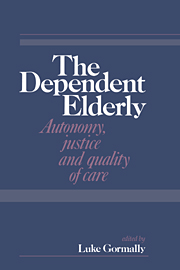Book contents
- Frontmatter
- Contents
- List of contributors
- 1 Introduction
- 2 Difficult choices in treating and feeding the debilitated elderly
- 3 The American debate about artificial nutrition and hydration
- 4 Reflections on Horan and Boyle
- 5 The Living Will: the ethical framework of a recent Report
- 6 Some reflections on euthanasia in The Netherlands
- 7 Is there a policy for the elderly needing long-term care?
- 8 Is it possible to provide good quality long-term care without unfair discrimination?
- 9 The prospects for long-term care: current policy and realistic alternatives
- 10 What is required for good quality in long-term care of the elderly?
- 11 Should age make a difference in health care entitlement?
- 12 Economic devices and ethical pitfalls: quality of life, the distribution of resources and the needs of the elderly
- 13 The Aged: non-persons, human dignity and justice
- 14 Economics, justice and the value of life: concluding remarks
- Index
7 - Is there a policy for the elderly needing long-term care?
Published online by Cambridge University Press: 01 October 2009
- Frontmatter
- Contents
- List of contributors
- 1 Introduction
- 2 Difficult choices in treating and feeding the debilitated elderly
- 3 The American debate about artificial nutrition and hydration
- 4 Reflections on Horan and Boyle
- 5 The Living Will: the ethical framework of a recent Report
- 6 Some reflections on euthanasia in The Netherlands
- 7 Is there a policy for the elderly needing long-term care?
- 8 Is it possible to provide good quality long-term care without unfair discrimination?
- 9 The prospects for long-term care: current policy and realistic alternatives
- 10 What is required for good quality in long-term care of the elderly?
- 11 Should age make a difference in health care entitlement?
- 12 Economic devices and ethical pitfalls: quality of life, the distribution of resources and the needs of the elderly
- 13 The Aged: non-persons, human dignity and justice
- 14 Economics, justice and the value of life: concluding remarks
- Index
Summary
It is clear where most of us would like to live when we are old. We would naturally wish to stay in our own homes and would only consider going into residential, nursing home or long-stay hospital accommodation as a last resort. It is difficult to provide a truly satisfying quality of care in continuing-care facilities and many old people who are in these places would prefer not to be there.
Long-term institutional care should be considered only after all other options have been thoroughly explored (Greengross 1987). It should be a carefully planned positive choice. Continuing care in institutions for the elderly should be available for those who actively want it and really need it. If this form of placement is appropriate, it should be provided in a supportive, homely environment where the individual's autonomy and privacy can be respected and where people can enjoy a good quality of life and high standards of care.
Ensuring that long-stay care is indicated and that the care provided is of the highest order requires careful strategic planning. Strategy originally meant the skill of a general: it was the art of conducting a military campaign by preparing and utilising forces so that the initiative would be secured and the war won.
- Type
- Chapter
- Information
- The Dependent Elderly , pp. 101 - 113Publisher: Cambridge University PressPrint publication year: 1992



